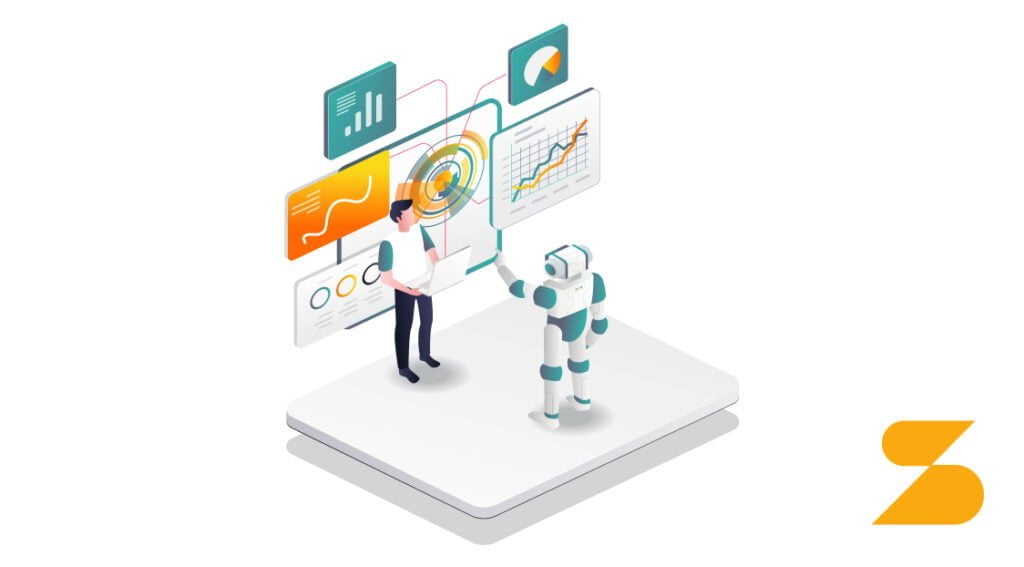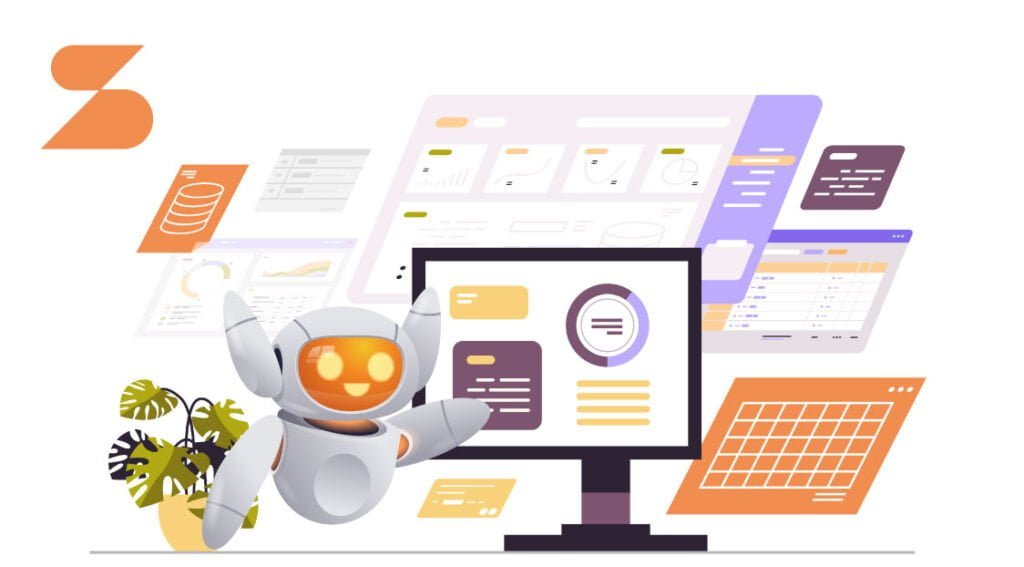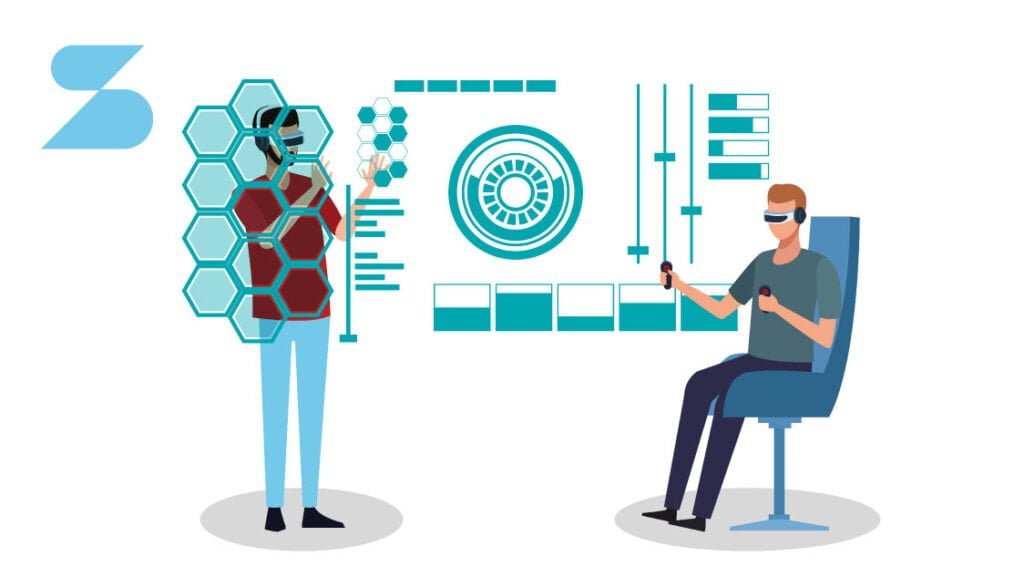Digitalization has significantly amplified the importance of user experience (UX) design, emphasizing the integration of machine learning (ML) techniques. Machine Learning in UX Design combines the principles of UX design with ML algorithms to create intuitive and enjoyable experiences for users while interacting with digital products or services.
It plays a crucial role in determining the success of websites, applications, and other digital platforms. With the emergence of machine learning (ML), UX designers now have a powerful tool to enhance user experiences further.

Machine learning algorithms can analyze vast amounts of user data, identify patterns, and make predictions, enabling personalized and tailored experiences. By incorporating ML into UX design, designers can gain valuable insights into user behavior, create adaptive interfaces, and provide relevant recommendations.
The growing role of Machine learning in UX design
Machine learning (ML) is playing an increasingly vital role in enhancing user experience (UX) design. ML, a branch of artificial intelligence, offers powerful techniques and algorithms that can transform the way we approach UX.
By analyzing user behavior and recognizing patterns, ML enables the creation of personalized user experiences. It empowers designers to develop recommender systems that deliver tailored content to individual users.
Additionally, ML automates usability testing, saving time and resources while ensuring a seamless user experience. Natural language processing, another ML application, aids in sentiment analysis of user feedback, enabling designers to gain valuable insights.

With predictive modeling, ML can anticipate user needs and behavior, allowing for adaptive interfaces that cater to users’ preferences. This growing role of ML in UX design is reshaping how we design digital experiences, leading to increased user satisfaction and engagement.
Understanding User Experience Design
User experience (UX) design plays a crucial role in creating satisfying digital interactions for users. In the context of machine learning (ML) in UX design, it is essential to comprehend the fundamentals.
“Machine learning offers unprecedented opportunities to elevate user experiences by leveraging data-driven insights and personalization.”
This section explores the definition and significance of UX design, shedding light on its importance in creating intuitive and enjoyable user experiences. It also delves into the key elements of effective UX design, highlighting the essential components that contribute to a seamless user journey.
Additionally, the section addresses the challenges faced by UX designers, providing insights into the obstacles they encounter while striving to deliver exceptional experiences.
Definition and Significance of UX Design
UX design involves creating intuitive and enjoyable experiences for users interacting with digital products. It emphasizes understanding user behavior, needs, and expectations to design interfaces that are easy to navigate, visually appealing, and functional.
Machine learning can assist UX designers by providing valuable insights into user preferences and behavior, leading to personalized and tailored experiences.
Elements of Effective UX Design

Effective UX design encompasses various elements that contribute to a seamless user experience. This includes clear and intuitive navigation, visually appealing design, concise and engaging content, responsive and accessible interfaces, and efficient task completion.
Machine learning can analyze user behavior patterns and preferences, allowing UX designers to optimize these elements and create experiences that align with user expectations.
Key challenges faced by UX Designers
UX designers encounter several challenges in their work. These challenges include understanding user needs and preferences, balancing aesthetics with functionality, ensuring accessibility for diverse user groups, optimizing performance and load times, and staying updated with evolving technology trends.
By leveraging machine learning techniques, UX designers can gain insights into user behavior, automate usability testing, and create predictive models that aid in addressing these challenges effectively.
Introduction to Machine Learning
Machine learning in UX design is an exciting and innovative approach that leverages the power of artificial intelligence to enhance user experiences. In this section, we will delve into the fundamental concepts of machine learning and its relevance to UX design.

Definition and basic principles of machine learning
Machine learning is a branch of artificial intelligence that enables computer systems to learn and improve from data without being explicitly programmed. It involves the development of algorithms that can automatically identify patterns and make predictions or decisions based on the data they analyze.
In the context of UX design, machine learning algorithms can help uncover insights and optimize user experiences through data-driven approaches.
How ML algorithms work
ML algorithms work by processing vast amounts of data and using statistical techniques to identify patterns and relationships within the data. They learn from this information and make predictions or take actions based on what they’ve learned.
ML algorithms can be categorized into supervised learning, unsupervised learning, and reinforcement learning, each with its own unique approach and application.
In the context of UX design, these algorithms can be utilized to understand user behavior, personalize experiences, and automate certain aspects of the design process.
Popular ML techniques and algorithms relevant to UX design

There are several ML techniques and algorithms that hold significant relevance to UX design. Some of the popular ones include:
- Collaborative filtering: This technique is commonly used for personalized recommendations by analyzing user behavior and preferences.
- Natural language processing (NLP): NLP algorithms help analyze and understand user feedback, sentiment, and interactions with chatbots or voice assistants.
- Predictive modeling: By leveraging historical data, predictive models can anticipate user needs and tailor interfaces accordingly.
- Clustering and segmentation: These techniques assist in grouping users based on similar characteristics, allowing for targeted UX improvements.
Overall, machine learning in UX design brings the potential to uncover valuable insights, personalize experiences, and automate certain design processes.
By understanding the basic principles and techniques of machine learning, UX designers can harness its capabilities to create more engaging and user-centric digital products and services.
Applications of Machine Learning in UX Design
Machine learning (ML) has revolutionized the field of user experience (UX) design by enabling personalized and optimized experiences. This section explores various applications of ML in UX design, highlighting how it enhances user experiences and streamlines design processes.
Personalized user experiences through ML
ML enables UX designers to create personalized experiences for users by analyzing user behavior and recognizing patterns. By understanding how users interact with a website or application, ML algorithms can make recommendations and provide tailored content based on individual preferences and past actions.
“Integrating machine learning in UX design allows us to anticipate user needs, deliver tailored experiences, and foster meaningful connections with our audience.”
User research and testing with ML
ML also plays a crucial role in user research and testing. Automated usability testing allows UX designers to gather data on user interactions and behavior without extensive manual efforts. Additionally, natural language processing techniques facilitate the analysis of user feedback, providing valuable insights into user sentiment and preferences.
Predictive modeling for UX optimization

Predictive modeling using ML algorithms helps UX designers anticipate user needs and behaviors. By leveraging historical data and patterns, ML can predict user actions and preferences, enabling designers to create adaptive interfaces that dynamically adjust to users’ expectations and deliver a more personalized experience.
Benefits and Challenges of Integrating Machine Learning in UX Design
Machine learning (ML) has become an invaluable tool in the realm of user experience (UX) design, offering a range of benefits while also posing certain challenges.
Benefits of ML in UX Design
Machine learning (ML) offers several benefits when integrated into user experience (UX) design.
“Ethical considerations and human-centered design principles must guide the application of machine learning in UX, ensuring technology serves the users while respecting their privacy and autonomy.”
Firstly, ML can enhance user satisfaction and engagement by analyzing user behavior patterns and tailoring experiences to meet individual preferences. This personalization leads to more meaningful interactions, ultimately resulting in higher levels of user satisfaction.
Secondly, ML enables improved conversion rates and business outcomes by providing personalized recommendations to users. These recommendations increase the likelihood of conversions and contribute to overall business success.
Challenges and considerations when using ML in UX design
While the benefits of integrating machine learning (ML) into UX design are significant, there are also specific challenges to be mindful of.
One of the primary challenges is addressing ethical considerations and data privacy. Designers must handle user data responsibly and securely, ensuring compliance with privacy regulations and obtaining proper consent.
Another challenge is striking the right balance between automation and human-centered design. While ML can automate certain processes and enhance efficiency, it is crucial to maintain a human touch and prioritize the needs and preferences of users throughout the design process.
Case Studies: Machine Learning in Real-World UX Design
In this section, we delve into real-world examples that demonstrate the powerful impact of machine learning (ML) on user experience (UX) design. We explore two specific cases where ML has been leveraged to enhance UX and deliver remarkable results.
Example 1: ML-powered personalized recommendations in e-commerce
ML has revolutionized the way e-commerce platforms provide personalized recommendations to users. By analyzing vast amounts of user data, ML algorithms can understand individual preferences and behaviors, enabling them to suggest products tailored to each user’s unique interests.
This implementation has had a profound impact on user experience, allowing customers to discover relevant products more efficiently and increasing their overall satisfaction.
Example 2: ML-driven chatbots for customer support

Another compelling application of ML in UX design is the use of ML-driven chatbots for customer support. By incorporating ML techniques, chatbots can better understand and respond to user queries, improving the quality of interactions.
ML enables chatbots to analyze user input and provide accurate and relevant information promptly. User feedback and satisfaction metrics indicate that ML-driven chatbots enhance customer support experiences, leading to increased user satisfaction.
Best Practices for Integrating Machine Learning into UX Design
Collaborative Approach between UX Designers and Data Scientists
To ensure the successful integration of machine learning (ML) into user experience (UX) design, a collaborative approach between UX designers and data scientists is crucial. This partnership allows for the effective utilization of ML algorithms and techniques to enhance UX.
By working together, UX designers can provide valuable insights into user needs and expectations, while data scientists can leverage their expertise to develop ML models that meet those requirements. This collaboration promotes a holistic approach that combines the power of ML with the creativity and user-centered thinking of UX design.
Iterative Design Process with Continuous User Feedback

An iterative design process that incorporates continuous user feedback is essential when integrating ML into UX design. This approach involves creating prototypes, testing them with real users, and gathering feedback to inform further design iterations.
By collecting user insights throughout the development cycle, designers can make data-driven decisions and refine their ML-powered solutions. This iterative approach ensures that the final product aligns with user expectations, resulting in improved user experiences.
Rigorous Testing and Evaluation of ML Models
When integrating ML into UX design, rigorous testing, and evaluation of ML models are paramount. Thorough testing helps identify potential issues, biases, or inaccuracies in ML algorithms, ensuring that they function reliably and effectively in real-world scenarios.
By conducting extensive testing, UX designers can validate the performance of ML models, optimize their accuracy, and address any ethical concerns. This rigorous evaluation process guarantees that the ML-powered UX design solutions meet the desired standards of performance, reliability, and user satisfaction.
Machine Learning in UX Design
In the conclusion, we summarize the key points regarding machine learning in UX design. We emphasize the benefits and applications of ML, such as personalized user experiences, improved conversions, and enhanced user satisfaction.
However, we also stress the importance of ethical considerations and human-centered design principles to ensure the responsible and respectful use of ML in UX design.
Lastly, we encourage UX designers to explore and embrace ML as a powerful tool that can significantly enhance user experiences. By leveraging ML techniques and collaborating with data scientists, UX designers can create more intuitive, efficient, and engaging digital products and services.
With this approach, we can strive for continuous improvement and provide users with exceptional experiences that meet their evolving needs and preferences.